Logical positivist philosophers have long claimed that the only thing worth believing is what we perceive through the senses. Neuroscience has conclusively shown that what we perceive is largely a projection of what we believe.
Always Explaining Things to Grown-ups
The following passage is the introductory chapter of Antoine Saint-Exupery’s classic, The Little Prince, in which he laments that so few can “see with the heart”.
Once when I was six years old I saw a magnificent picture in a book, called True Stories from Nature, about the primeval forest. It was a picture of a boa constrictor in the act of swallowing an animal. Here is a copy of the drawing.

In the book it said: “Boa constrictors swallow their prey whole, without chewing it. After that they are not able to move, and they sleep through the six months that they need for digestion.”
I pondered deeply, then, over the adventures of the jungle. And after some work with a colored pencil I succeeded in making my first drawing. My Drawing Number One. It looked something like this:

I showed my masterpiece to the grown-ups, and asked them whether the drawing frightened them.
But they answered: “Frighten? Why should any one be frightened by a hat?”
My drawing was not a picture of a hat. It was a picture of a boa constrictor digesting an elephant. But since the grown-ups were not able to understand it, I made another drawing: I drew the inside of a boa constrictor, so that the grown-ups could see it clearly. They always need to have things explained. My Drawing Number Two looked like this:

The grown-ups’ response, this time, was to advise me to lay aside my drawings of boa constrictors, whether from the inside or the outside, and devote myself instead to geography, history, arithmetic, and grammar. That is why, at the age of six, I gave up what might have been a magnificent career as a painter. I had been disheartened by the failure of my Drawing Number One and my Drawing Number Two. Grown-ups never understand anything by themselves, and it is tiresome for children to be always and forever explaining things to them.
Wittgenstein’s Duckrabbit
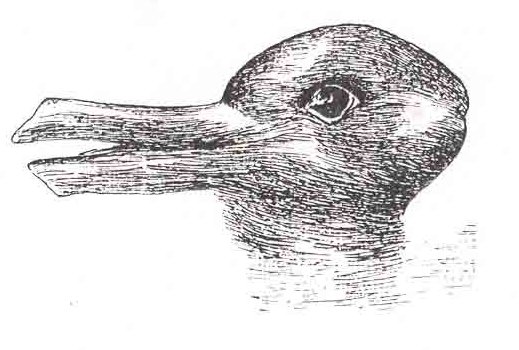
Wittgenstein (and by Wittgenstein, I mean late Wittgenstein) presented the duckrabbit as a paradox of philosophical inquiry as a means of truthfinding. In philosophy of mathematics, the law of the excluded middle declares that all propositions must be either true or false. Consider the following statements:
- The above image is a duck.
- The above image is a rabbit.
- The above image is a duck and a rabbit.
- The above image is neither a duck nor a rabbit.
When our rigid logical constructs fail, we have to seek more sublime forms of reasoning. The duckrabbit is the one of the emblems of Neuromythography. The brain is a duckrabbit of sublime complexity that defies language-games.
Sensation Is Not Separable From Interpretation
It is known that the senses are projected from sensory organs upwards towards the neocortex of the brain. What is less appreciated is that there are projections downwards from higher levels that are at least as extensive as those that project upwards. Let us take the eyes, for example.
Traditional Visual System View
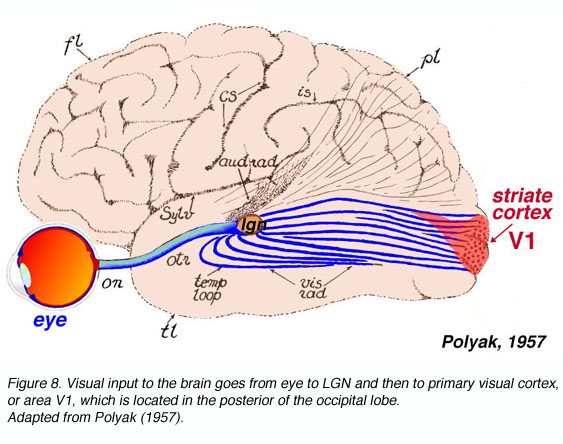
The visual region of the occipital cortex is portrayed in textbooks like a layered movie screen, with they eye projecting to the lateral geniculate nucleus of the thalamus to V1 of the cortex
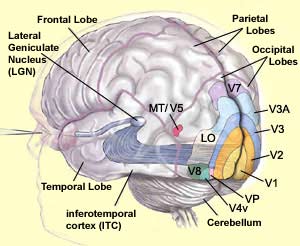
Images are then processed through a progressive pipeline from V1 to V8.

These processed visual images are then further processed via two pipelines, the dorsal stream ‘what pathway’ and the ventral stream ‘where pathway’.
The what pathway progresses through the inferior temporal lobe, classifying images by color, object composition, scene, category, symbolic interpretation, and so on, with progressively more general classification from the back to the temporal pole.
The where pathway progresses through the superior parietal lobe, inventorying the images by location, distance, quantity, handle points, and so on, to prepare for the selection and manipulation of objects.
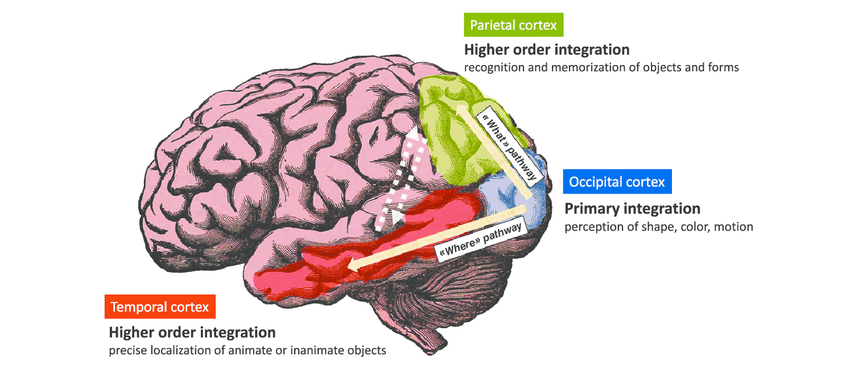
It should be noted that even researchers get confused. Consider this example published in a paper by a neuroscience researcher who has more than 2,600 citations, where he mistakenly reversed the what and where pathways.
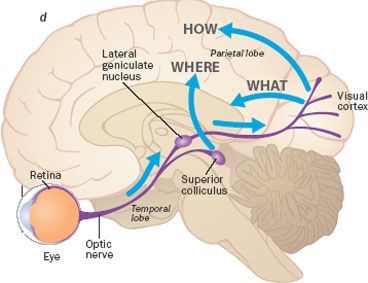
Or take for example this image from a neuroscience textbook, that looks like a cross between an English grammarian and a Paris street map. Ironically, the nature of brain vision itself is an interpretable duckrabbit even for those who have been through neuroscience education.
| PERCEPTION | POSSIBILITY | CONTRAST | HIDDEN | OBJECT INDEX | PROPERTY INDEX | OBJECT TRACKING | SELF-MOTION | TARGET RECKONING | VISUAL SEARCH | COLOR | ||
| SC | V1 | V2 | V3 | V3a | V3b | V4 | MT (V5) | V6 | V6a | V7 | V8 | |
| TF | BINDING | BINDING | BINDING | BINDING | BINDING | BINDING | BINDING | |||||
| 8BM | REVERENCE | REVERENCE | REVERENCE | |||||||||
| 8BL | COULD | COULD | COULD | COULD | COULD | |||||||
| a10p | ALTERNATIVES | ALTERNATIVES | ALTERNATIVES | ALTERNATIVES | ||||||||
| p10p | GOAL SEQUENCES | GOAL SEQUENCES | ||||||||||
| a47r | NAVIGATION | NAVIGATION | NAVIGATION | NAVIGATION | NAVIGATION | NAVIGATION | ||||||
| 9a | SELF-EVAL: WHY | SELF-EVAL: WHY | SELF-EVAL: WHY | SELF-EVAL: WHY | SELF-EVAL: WHY | |||||||
| 9p | SELF-EVAL: PERF | SELF-EVAL: PERF | SELF-EVAL: PERF | SELF-EVAL: PERF | SELF-EVAL: PERF | |||||||
| FOP5 | COMPASSION | COMPASSION | COMPASSION | |||||||||
| TGv | PROPERTIES | PROPERTIES | PROPERTIES | PROPERTIES | ||||||||
| TGd | GESTALT | GESTALT | GESTALT | GESTALT | ||||||||
| TE1a | STEREOTYPES | STEREOTYPES | STEREOTYPES | |||||||||
| IPS1 | OBJECT CONSTANCY | OBJECT CONSTANCY | OBJECT CONSTANCY | |||||||||
| IP0 | MEASURING | MEASURING | MEASURING | |||||||||
| 45 | RECALL | |||||||||||
| TPOJ3 | SUBJECT-VERB-SCHEMA |